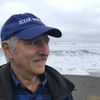The following is excerpted from my book: Rescue Warriors - The U.S. Coast Guard America's Forgotten Heroes (now in paperback).
Friday, August 26, 2005
The crew of the fishing boat Mary Lynn pitched and rolled in raging forty-foot seas, eighty-five miles west of Key West. With their controls gone and their vessel threatening to break up, they activated an EPIRB (emergency position-indicating radio beacon) buoy and hoped someone would hear its signal. They tried to launch a life raft, but the storm winds capsized it and dragged it away. All they could do now was hang on and pray for help.
At Coast Guard Air Station Clearwater, 210 miles away, their signal was received and an HH-60 Jayhawk helicopter launched in forty-knot winds around 10 P.M. Soon the big chopper was flying along the leading edge of the storm, blinded by heavy rains, clouds, and darkness, its crew unable to see the ocean rising and falling below them. It would take three hours of manhandling their aircraft through buffeting winds and ballistic rain before they finally arrived on scene. A big four-engine C-130 Hercules from Clearwater was already circling overhead.
Unfortunately, the rough trek had depleted the helicopter's fuel supply, leaving them only fifteen minutes on scene. Below they could see the Mary Lynn being tossed around in the rolling seas as the crew clung to the stern. Rather than try to rush things and risk someone being swept away, they decided to head to Key West to refuel. Battling 75 mph headwinds, the trip, which should have taken forty-five minutes, took two hours. They landed at 3:00 A.M., refueled, and were back over the Mary Lynn at daybreak. If anything, the storm had worsened in their absence. Pilot Craig Massello told Rescue Swimmer Kenyon Bolton that he was not to come off the rescue cable for any reason. This meant the boat crew would have to get in the water to meet him.
"The first hoist wasn't pretty," flight mechanic and hoist operator Robert Cain noted dryly. First they swung Bolton into the stern of the fishing boat, and then, as he came free, dangling like bait on a line, he was hit head-on by a monster wave. Still he managed to get in the water and swim to crewmember Anita Miller. He got a quick strop harness around her, but then the cable jerked them, dropping the strop's V-rings and jamming his hook open. He replaced the rings and made sure he had a tight grip on her, then got them lifted back aboard the helicopter and determined that his cable hook, though damaged, was still operable. He went back down for his second hoist. This time a lifeline from the foundering boat to the second crewmember in the water got entangled with the hoist cable. This was even less pretty. Were the boat to sink at this point, it could drag the survivor, the rescue swimmer, even the helicopter down with it. While Bolton and the fisherman remaining on the Mary Lynn worked to free the line, a shark two or three feet long swam through Bolton's legs. "I was surprised it was so close to the surface...It made me think twice about what was out of sight," he later recalled.
With the lines cleared, he was able to make the second hoist. The third hoist went without a hitch (or much of a functioning hook). The entire rescue took around thirty minutes. Rather than fight the winds to Key West, they headed toward Clearwater. With cyclonic tailwinds, they made around two hundred knots ground speed, "ridiculous for a helicopter," grinned copilot Dave Sheppard who, like the rest of the crew, was now riding an adrenaline high.
The storm, which had already battered Florida, leaving six dead, would continue to pick up strength as it crossed the unusually warm waters of the Gulf of Mexico. The survivors of the Mary Lynn - Mark Gutek, Anita Miller, and Charles White - would be the first three of thirty-three thousand people to be rescued by the U.S. Coast Guard in the coming days as Hurricane Katrina continued on towards the Mississippi Gulf Coast, New Orleans, and the history books.
